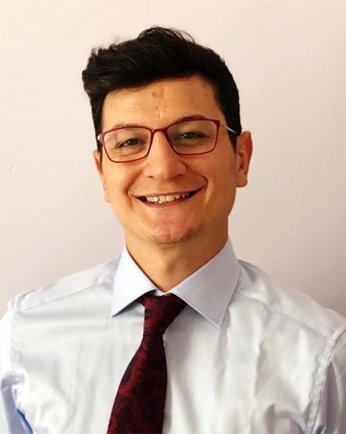Poster Presentations:

Graduate Student Researcher
UCLA
Seismic Fragility Analysis and Resilience Assessment of Standard Ordinary Concrete Box Girder Bridges with SMA-Reinforced ECC Columns: In Accordance with Possible Design Scenarios in California
Abstract: The performance objective of current seismic design guidelines such as CALTRANS or LRFD for ordinary bridges follows the life-safety design premise, where significant structural damage is possible under large earthquakes while the risk of collapse is minimized. In order to mitigate the overall damage level of bridges from earthquakes and improve their post-earthquake serviceability, one of the solutions being explored by the research community is the use of advanced materials that are mechanically superior compared to conventional ones in bridge columns.
SMA-reinforced ECC columns (SMA-ECC in short) were developed to help further seismic performance of bridges, following current design standards. This novel column concept leverages the self-centering capability of SMA and damage-tolerant properties and the high tensile capacity of ECC.
Even though the SMA-ECC column is a proven seismically resilient bridge column concept, incorporation of this novel column concept in new bridge construction is still extremely limited. Studies that comprehensively evaluate the change in seismic performance of existing bridges by replacing their columns with SMA-ECC columns can shed light on the ability of this new column in mitigating physical earthquake damage on bridges and its contribution to enhance post-earthquake serviceability of bridges.
This study aims to investigate the change in seismic resilience of a specific bridge class and type from an existing inventory when the conventional columns are replaced by SMA-ECC Columns. To that end, numerical simulations, incorporating uncertainties associated with bridge geometric and material properties and soil-structure interaction effects, will be conducted on both bridges with conventional and SMA-ECC columns.

Graduate Student Researcher
University at Buffalo
Numerical Modelling of a Retrofittted Unreinforced Masonry Shake Test
Co-Authors: Andreas Stavridis (University at Buffalo)
Abstract: This presentation discusses the numerical models recently developed and calibrated to a series of full-scale shake tests conducted at the University at Buffalo. Shake testing was conducted on an unreinforced masonry building retrofitted based upon ASCE 41 and typical industry practices. The generated data set is unique because the structure incorporated a complete, retrofitted, unreinforced masonry building system representative of historic US construction practices, which was subjected to simultaneous bi-directional shaking. Shake testing was conducted until partial collapse of the parapet and other significant damage prevented further testing. This dataset enabled a numerical model to be developed and calibrated to capture the structural response of an unreinforced masonry building system to a near collapse damage state. The model was calibrated to include the complex behavior in wall corners which have been observed to be vulnerable to collapse in real buildings. This included in-plane and out-of-plane rocking as well as shear sliding. The model explicitly represented cracking in mortar joints, cracking through bricks, and crushing of masonry. The timber diaphragm and the steel retrofit system were included in the numerical model.

Associate Professor
University of Canterbury
How to model energy dissipation without using problematic Rayleigh damping?
Abstract: In the simulations of seismic response of large-scale structures, thanks to its mathematical convenience and computational efficiency, the Rayleigh damping model is often used to incorporate un-modelled energy dissipations in the structure not accounted for using material hysteretic models. Recent studies have proved that the Rayleigh model is not only inflexible to match desired damping ratios for more than two vibration modes, but also often results in spurious damping forces in the same order of magnitude as member forces. These erroneous forces lead to an underestimate of seismic demands on structures, resulting in an unconservative structural design. This paper presents a new damping model to overcome all the above-mentioned problems of the Rayleigh model. This new model, named the bell-shaped model, not only maintains the same order of computational efficiency as the Rayleigh model but also allows users to customize a state-dependent energy dissipation when the structure responds inelastically to extreme seismic loading. The properties and advantages of the bell-shaped damping model will be discussed in this paper with examples.

Undergraduate Student Researcher
University of California, San Diego
Development of a Parametrized Fragility Database for Performance-Based Structural Fire Engineering
Abstract: Fire fragility functions are mathematical tools used to calculate the probability that a structure will exceed a given limit state when subjected to a fire load of a specific intensity measure (IM). They are an effective tool for evaluating the probabilistic risk of structures to fire while incorporating the effects of various uncertain factors on structural response. They, however, have not been thoroughly investigated to create a database of fragility curves for the fire hazard. In this research, a database of fire fragility functions, parametrized over the demand-to-capacity ratio (DCR) and section size, was developed for columns in steel moment frames. In the deterministic failure analysis step, the Eurocode Parametric Fire model and steel temperature development equations were applied to determine the global elastic buckling failure of columns subjected to fire. Monte Carlo Simulations (MCS) were then used to account for uncertainties in structural and thermal properties, generating failure probability estimates under different fire loads. The DCR and section sizes were systematically varied to produce fragility data for various combinations of column input parameters. The resulting fragility curves were described in the database by the median and beta (log standard deviation) fitted parameters, which correspond to a lognormal distribution function. To demonstrate the practical application of this database, a risk assessment was performed on a prototype steel column using the pre-calculated fragility curves in the database.

Graduate Student Researcher
UC Berkeley
Recent Advances in the Nonlinear Simulation of Beam-Columns: Mathematical Foundations and OpenSees Implementations
Co-Authors: Filip C. Filippou (UC Berkeley) and Khalid Mosalam (UC Berkeley)
Abstract: A novel computational framework is developed for nonlinear finite element analysis of frames and shells. The proposed framework is shown to furnish a novel geometrically exact frame element that rectifies the lack of objectivity of prior formulations without violating model constraints or compromising symmetry of the tangent stiffness at equilibrium. The proposed framework is consistent with both Petrov-Galerkin and Bubnov-Galerkin formalisms and in both cases is shown to admit an element-independent architecture which resembles the well-known geometric transformation abstraction popularized by the open-source platform OpenSees.
Geometrically exact finite elements often provide significantly greater accuracy compared to elements based on truncated strain measures when modeling problems with large displacements. However, very few simulation platforms offer such elements as they often do not fit easily into standard finite element architectures and users may be deterred by their tendency to exhibit alarming properties like path dependence and material frame dependence. The proposed formulation addresses these difficulties and presents the first such implementation in OpenSees.

Graduate Student Researcher
University of California, San Diego
Model Updating of Dam-Water-Foundation Rock System Applied to Pine Flat Concrete Gravity Dam
Co-Authors: Joel P. Conte (University of California, San Diego)
Abstract: Driven by the critical need to improve dam safety against natural hazards, this paper presents Bayesian model updating of a 2D nonlinear FE model of a dam-water-foundation rock system representing the Pine Flat concrete gravity dam on the King’s River near Fresno, California.
The developed FE model incorporates key effects that influence a dam's response during seismic events. These include dam-water interaction, accounting for water compressibility; energy dissipation resulting from wave absorption by sediments at the reservoir bottom; dam-foundation rock interaction, considering the mass/inertia, flexibility, and hysteretic damping of the rock; and radiation damping due to the semi-infinite extent of the water reservoir and foundation-rock domains. The nonlinear material behavior of the plain concrete of the dam and of the rock in the near-field foundation-rock domain is modeled using a state-of-the-art damage-plasticity model (ASDConcrete3D). The model is implemented in STKO-OpenSees.
Bayesian Model updating is performed in the batch mode using the Transitional Markov Chain Monte Carlo (TMCMC) method. Numerically simulated seismic response data with added Gaussian white noise (to simulate the measurement noise) is assumed to represent data measured from a real-world dam and is used as measurement data in this study. In simulating such measurement data, sensors measuring absolute acceleration response time histories are assumed to be installed at various heights along the downstream face of the dam.
Limitations in terms of applicability and computational challenges of this method for model updating of large-scale nonlinear FE models are addressed and discussed. Sensitivity analysis of the model is performed using variance-based global sensitivity analysis (Sobol’s method) to identify the most influential parameters for inclusion in the model updating phase.

Professor
Università G. d'Annunzio di Chieti-Pescara, Italy
Hybrid GFRP/Steel dissipative connecition: a numerical validation study
Co-Authors: Kaushal Patel (Università G. d'Annunzio di Chieti-Pescara), Guido Camata (Università G. d'Annunzio di Chieti-Pescara), and Antonio Nanni (University of Miami)
Abstract: Using Glass Fiber Reinforced Polymers (GFRP) as reinforcement in concrete structures offers several key advantages, particularly in environments prone to corrosion, such as coastal or industrial areas. GFRP's excellent corrosion resistance and lighter weight make it an attractive alternative to traditional steel reinforcement. These properties simplify handling and installation, reduce labor costs, and enhance overall design efficiency for structure durability.
However, GFRP has inherent drawbacks, particularly its limited ductility compared to steel. These limitations pose challenges in seismic zones where structures must withstand dynamic loads and maintain structural integrity. To address these concerns, a hybrid reinforcement strategy is proposed, combining GFRP and steel in critical regions. This approach takes advantage of GFRP’s corrosion resistance in less critical areas while relying on steel’s superior ductility in dissipative zones, ensuring that the structure can dissipate energy effectively during seismic events.
Comprehensive computational modeling using advanced 3D nonlinear finite element analysis with STKO and OpenSees was undertaken to evaluate the performance of this hybrid reinforcement approach. The focus was on critical structural components, such as foundation and beam-column joints, and reinforced concrete frames. The solid models accounted for complex material behaviors, including the plasticity of concrete, hysteresis of steel, bond-slip effects, rebar buckling, and the elastic-brittle properties of GFRP. The results showed that hybrid structures reinforced with GFRP and steel demonstrate ductility comparable to traditional steel-reinforced structures. These findings indicate that the hybrid approach offers a viable and promising solution for improving structures' performance, durability, and lifespan, especially in seismic regions.

Graduate Student Researcher
UC Berkeley
Dynamic interaction effects in the vertical response of primary and secondary systems
Co-Authors: Dimitrios Konstantinidis (University of California Berkeley)
Abstract: Damage to nonstructural components (NSCs) is a major contributor to seismic risk. Although advancements have been made in understanding the dynamic behavior of buildings and seismic demands on NSCs horizontally, assessing their vertical response remains unresolved. A key issue is the dynamic interaction between primary (buildings) and secondary (NSCs) systems in the vertical direction, which differs from the horizontal direction. In real buildings, NSCs are mainly located on slabs that behave differently than frame elements, significantly affecting the accurate assessment of seismic demands on NSCs.
This study addresses this knowledge gap by investigating both vertical and horizontal responses of three-dimensional buildings. It examines dynamic interactions between primary and secondary systems, considering spatial variability of slab responses on floors and along building heights based on mass and stiffness ratios using OpenSEES. Nonlinear time history analyses were performed for NSCs in three mass categories (light, medium, and heavy), as classified by the California Department of Health Care Access and Information (HCAI), using both coupled and decoupled dynamic analyses. These included both flexible and rigid NSCs positioned on slabs, beam lengths, and column lines in code-compliant steel moment-resisting hospital buildings.
The findings from the coupled and decoupled analyses show that vertical dynamic interaction occurs at smaller mass ratios than in the horizontal direction, challenging current criteria for neglecting such interactions. Additionally, vertical acceleration demands on NSCs are higher and vary across the same floor level, leading to non-uniform seismic demands, unlike the assumed uniformity in current approaches.